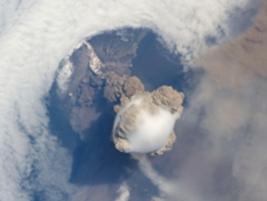[2015] Quantifying the impact of volcanic eruptions on climate
Large volcanic eruptions inject considerable quantities of sulfur in the stratosphere. After conversion into aerosols, these particles block part of the solar radiation and tend to cool the surface of the Earth for a few years. An international team of researchers has just developed a method, presented in the journal Nature Geoscience, to accurately measure and simulate the induced cooling.
The eruption of the Pinatubo volcano, which occurred in June 1991 and is considered as the most important of the 20th century, injected 20 million tons of sulfur dioxide into the stratosphere and caused an average global cooling of 0.4 ° C. In order to quantify the temporary cooling induced by large eruptions of magnitude greater than that of Mount Pinatubo during the last 1,500 years, scientists generally use two approaches: dendroclimatology, based on the analysis of tree rings, and numerical simulation in response to the effect of volcanic particles. But up to now these two approaches yielded rather contradictory results, which did not make it possible to determine precisely the impact of major volcanic eruptions on climate. The cooling simulated by climate models was indeed two to four times larger and lasted longer than the dendroclimatic reconstructions had established. The differences between these two approaches have even led some geophysicists to doubt the ability of tree rings to record the climatic impacts of past large volcanic eruptions and to challenge the ability of models to accurately simulate them.
Researchers from the University of Geneva (UNIGE), IRD), CNRS, CEA, the University of Bern, the University of Western Ontario and the University of Cambridge reconcile the two approaches and propose a method that can accurately estimate the effects of future high-magnitude eruptions on the climate and then better anticipate their impacts on our societies. In this multidisciplinary team, dendrochronologists have made a new reconstruction of summer temperatures in the northern hemisphere for the past 1500 years. They analyzed the width but especially the density of tree rings, which is very sensitive to temperature variations and which had been neglected in the past. Data were collected throughout the Northern Hemisphere, from Scandinavia to Siberia, through Quebec, Alaska, the Alps and the Pyrenees. All major eruptions were clearly detected in this reconstruction. The results showed that the year following a major eruption is characterized by a more pronounced cooling than observed in previous reconstructions. However, these cooling events do not appear to persist for more than three years on a hemispheric scale.
For their part, climate physicists calculated the cooling caused by the two largest eruptions of the last millennium, the eruptions of Samalas and Tambora, both of which occurred in Indonesia in 1257 and 1815 respectively. The model used in this study takes into account the localization of the volcanoes, the eruption season and the injection height of sulfur dioxide and incorporates a microphysical module capable of simulating the life cycle of volcanic aerosols since their formation, following oxidation, to their sedimentation and removal from the atmosphere. "This unusual approach can realistically simulate the size of volcanic aerosol particles and their life expectancy in the atmosphere, which directly conditions the magnitude and persistence of the cooling caused by the eruption," says Markus Stoffel , researcher at UNIGE. These new simulations show that disturbances in radiation exchanges due to volcanic activity were largely overestimated in the previous simulations used in the latest IPCC (Intergovernmental Panel on Climate Change) report.
For the first time, the results produced by the reconstructions and climatic models converge with respect to the intensity of the cooling and show that the eruptions of Tambora and Samalas induced, on the scale of the northern hemisphere, an mean cooling between 0.8 and 1.3 ° C during the summers 1258 and 1816. The two approaches also agree on the average persistence of this cooling estimated at two-three years. These results open the way to a better assessment of the role of volcanism in climate change.
Reference: Stoffel, M., Khodri, M., Corona, C., Guillet, S., Poulain, V., Bekki, S., Guiot, J., Luckman, B.H., Oppenheimer, C., Lebas, N., et al. (2015). Estimates of volcanic-induced cooling in the Northern Hemisphere over the past 1,500 years. Nat. Geosci. 8, 784.
Press release: http://www.insu.cnrs.fr/node/5428
Figure: Plinian panache of the eruption of Sarychev (Russia) on 12 June 2009. (c) Nasa

